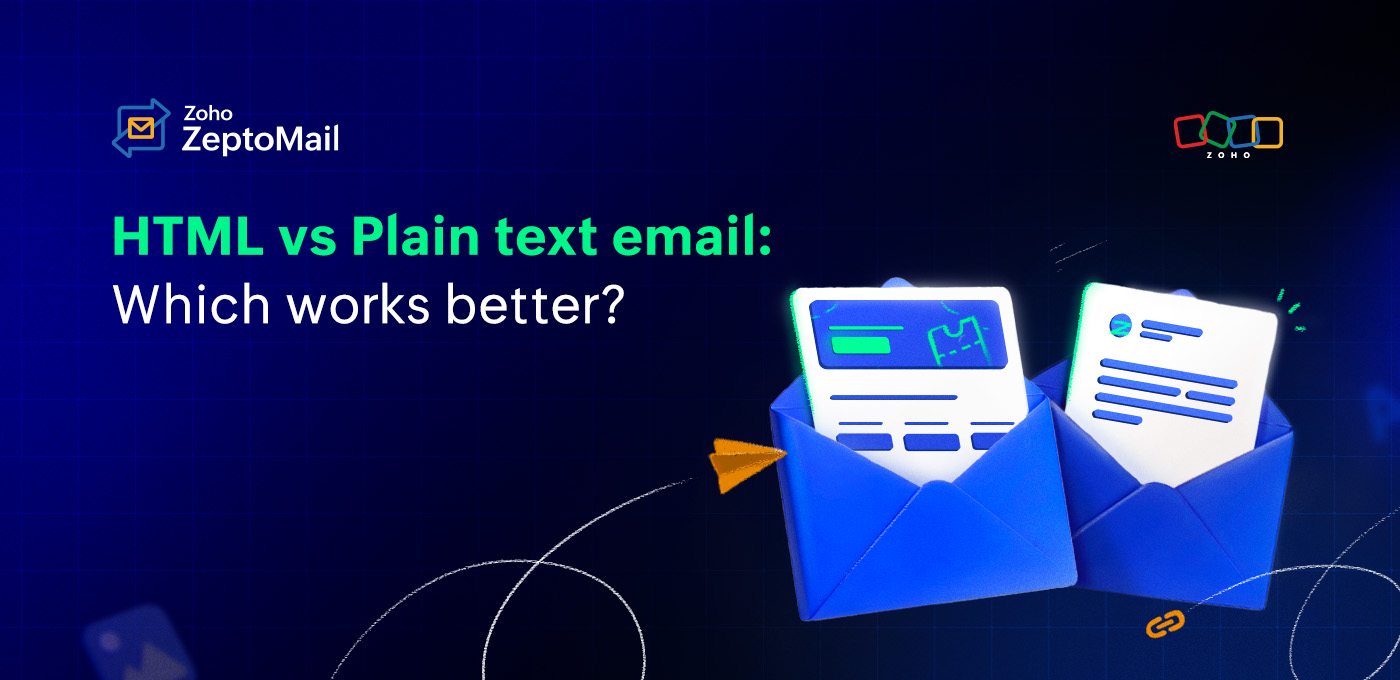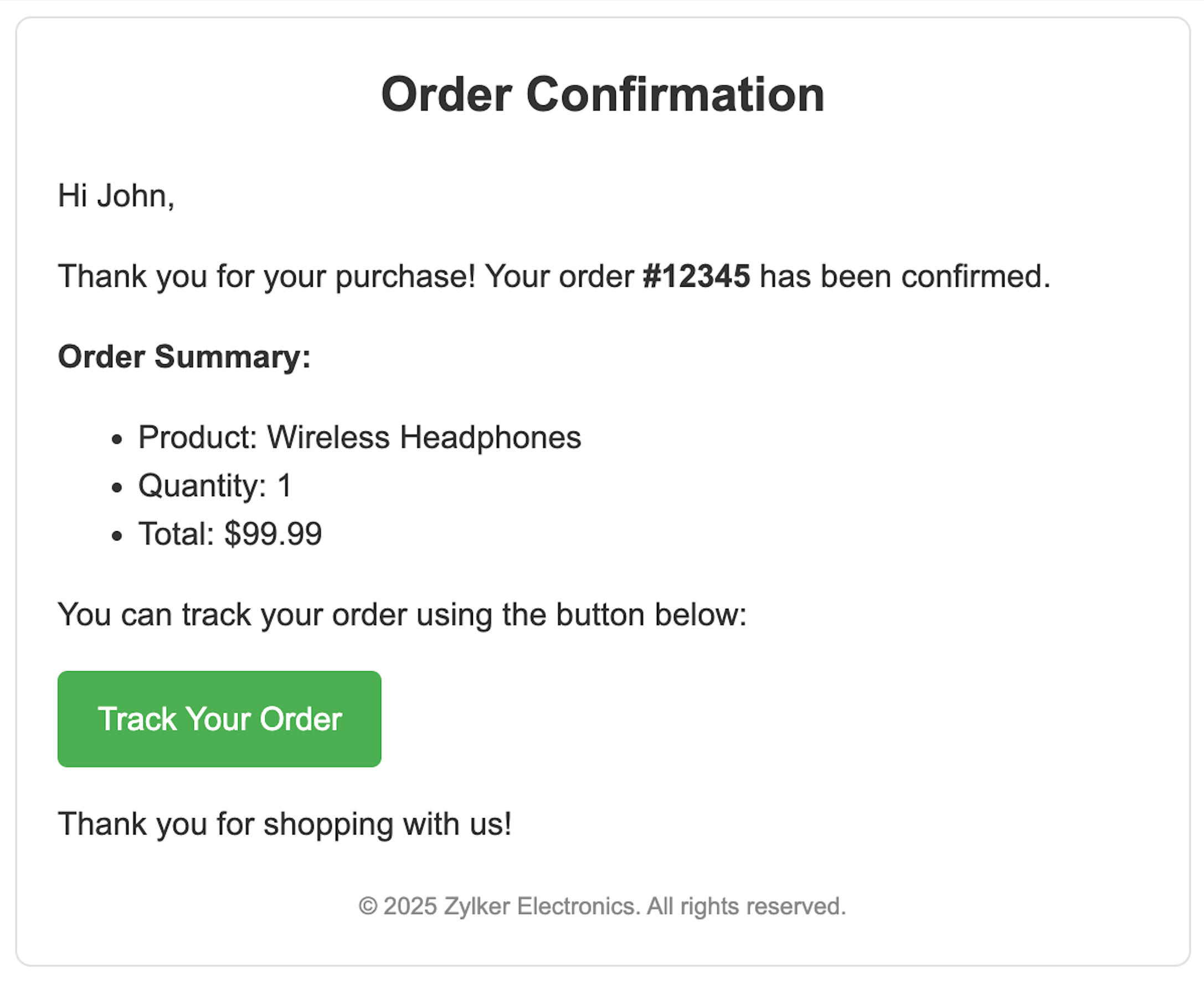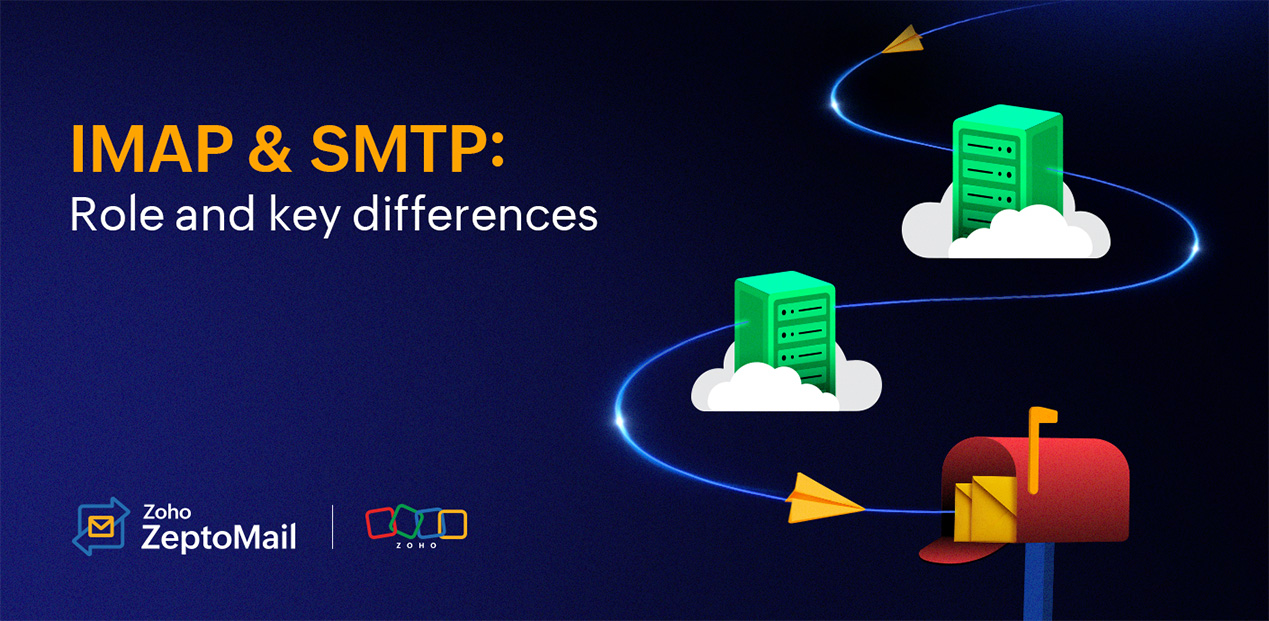- HOME
- Email sending
- HTML vs. plain text email: Which works better?
HTML vs. plain text email: Which works better?
- Published : October 23, 2025
- Last Updated : October 27, 2025
- 170 Views
- 6 Min Read
When it comes to email communication, one debate just won’t go away: HTML or plain text emails? HTML emails are flashy, visually rich, and perfect for marketing campaigns, while plain text emails are simple, personal, and often better at slipping through spam filters.
So, which one should you actually use for your business in 2025? Let’s break it down, with a focus on better email deliverability and engagement.

What is an HTML email?
A Hypertext Markup Language, or HTML, email uses code to include design elements such as fonts, colors, images, buttons, and even animations. Think of it as a mini web page delivered to your inbox.
These are the kinds of emails you often receive from brands promoting their products, sharing newsletters, or offering discounts.
Example of an HTML email
Subject line: Your Order #12345 is Confirmed!
<html>
<head>
<style>
body { font-family: Arial, sans-serif; color: #333; line-height: 1.5; }
.container { max-width: 600px; margin: 0 auto; padding: 20px; border: 1px solid #e0e0e0; border-radius: 8px; }
.header { text-align: center; font-size: 24px; font-weight: bold; margin-bottom: 20px; }
.button { background-color: #4CAF50; color: #fff; padding: 12px 20px; text-decoration: none; border-radius: 5px; display: inline-block; }
.footer { font-size: 12px; color: #888; text-align: center; margin-top: 20px; }
</style>
</head>
<body>
<div class="container">
<div class="header">Order Confirmation</div>
<p>Hi John,</p>
<p>Thank you for your purchase! Your order <strong>#12345</strong> has been confirmed.</p>
<p><strong>Order Summary:</strong></p>
<ul>
<li>Product: Wireless Headphones</li>
<li>Quantity: 1</li>
<li>Total: $99.99</li>
</ul>
<p>You can track your order using the button below:</p>
<p><a href="https://example.com/track-order/12345" class="button">Track Your Order</a></p>
<p>Thank you for shopping with us!</p>
<div class="footer">
© 2025 Zylker Electronics. All rights reserved.
</div>
</div>
</body>
</html>
After adding your HTML code, your email will be generated and displayed just like the one shown below.
HTML emails typically include:
A branded header image
A large CTA button
Product visuals
Custom fonts and colors
Clean, attractive, and attention-grabbing elements—perfect for promotional or newsletter-style emails
HTML emails are best suited for:
Marketing campaigns, newsletters, promotional announcements, and onboarding emails.
Pros of using HTML emails
Visually engaging with images, CTAs, and layout design
Easier to track clicks and opens
Responsive templates for better mobile viewing
Reinforces brand identity with logos and colors
Cons of using HTML emails
Can trigger spam filters if too image-heavy or poorly coded
Slightly longer load time
May not display properly on all email clients (especially if their privacy settings are strong)
What is a plain text email?
A plain text email contains only text without any colors, images, links with tracking, or fancy formatting. It feels personal, like a one-to-one message.
While it may look simple, plain text emails have a strong advantage. They often perform better in terms of deliverability and trust.
Example of a plain text email
Subject line: Your Order #12345 is Confirmed!
Hi {{John}},Thank you for your purchase! Your order {{#12345}} has been confirmed.
Order Summary:
- Product: {{Wireless Headphones }}
- Quantity: {{1 }}
- Total: {{$99.99 }}
You can track your order using the link below:
Button: {{Track My Order}}Thank you for shopping with us!
The {{Zylker Electronics}} Team
Plain text emails usually have:
No images
No CTAs
Just a friendly message that feels personal
Informal format
Plain text emails are best suited for:
Transactional emails (OTPs, order confirmations, password resets), trigger-based emails, follow-ups, and personalized outreach.
Pros of using plain text emails
Higher deliverability and inbox placement
Feels more personal and human
Loads instantly on all devices
Less likely to be marked as spam
Cons of using plain text emails
No visual appeal or brand consistency
Cannot track link clicks or measure engagement easily
Limited formatting options
HTML vs. plain text emails: Key differences
Aspect | HTML email | Plain text email |
Appearance and layout | Rich layout with fonts, colors, images, columns, and buttons | Monospaced or simple text only (no styling) |
Formatting options | Full control over fonts, colors, spacing, lists, tables | No formatting beyond line breaks and spacing |
Calls-to-Action (CTAs) | Clear, clickable buttons and tracked links | Hyperlinking only (no buttons) and less visual emphasis |
Images and media | Supports images, GIFs, embedded video previews | Cannot show images |
Deliverability and spam risk | Higher design complexity can trigger spam filters if poorly coded | Often ensures better inbox placement and successfully passes through spam filters |
Security and privacy | Tracking pixels raise privacy concerns for some recipients | Perceived as more private (no invisible tracking) |
Tracking and analytics | Easy tracking (opens via pixels, link clicks) | Limited tracking (only link clicks if present) |
Accessibility | Can be accessible but requires extra effort (alt tags, semantic HTML) | Highly accessible by default (screen readers read text) |
Mobile responsiveness | Responsive design possible (media queries, fluid layouts) | Always mobile-friendly (simple text wraps naturally) |
Client compatibility | Can render differently across email clients and needs testing | Universally consistent across clients |
Load time | Heavier images, CSS files take longer to load | Very lightweight and fast |
Personalization | Supports dynamic blocks, custom fonts, advanced personalization tokens | Supports tokens but no styling control |
Creation effort | Takes a longer time to design, HTML/CSS, testing across clients | Easier to create (write and click Send) |
Editing and maintenance | Requires design and development skills to update and test | Easy to edit as no coding is required |
Use cases | Newsletters, promotional campaigns, onboarding, receipts with rich visuals | Transactional email alerts, CEO/personal notes, critical system messages, deliverability-focused emails |
HTML or plain text: Which should you choose?
The debate about HTML vs. plain text email isn’t about picking one over the other. It’s all about knowing when and how to use each. HTML emails help your brand stand out visually and drive engagement through strong calls-to-action. Plain text emails, on the other hand, feel genuine, improve deliverability, and build trust.
For most businesses, the winning formula is a combination of both: HTML for appeal and plain text for authenticity.
Here’s a table on when to use each to increase the potential of your emails landing in recipients' inboxes.
Email type | Recommended format |
|---|---|
Transactional emails (order confirmations, password resets, OTPs) | Plain text or light HTML |
Marketing emails/campaigns (promotions, product launches, sales) | HTML |
Newsletters | HTML |
System alerts and notifications | Plain text |
Customer Onboarding Emails | HTML (with plain text fallback) |
Follow-up or re-engagement emails | Plain-text style HTML |
Event invites and webinar announcements | HTML |
Internal updates | Plain text |
Bulk system notifications | Plain text |
Which one works better for deliverability and engagement?
While plain text emails are preferred by many, the right choice ultimately depends on your business goals.
For better deliverability, always use plain text emails. They’re simple and more likely to pass spam filters. This is especially true for transactional emails. If you use HTML emails for OTPs or password resets, there’s a chance they may break due to heavy data like images or files. This can also make them appear suspicious to spam filters.
On the other hand, when sending marketing, promotional emails, or newsletters, you need something more engaging. For higher engagement, click-throughs, and conversion rates, HTML emails perform better. Their visuals, CTAs, and interactive elements encourage readers to take action.
Why should you combine both HTML and plain text emails?
Many businesses and marketers now use a hybrid approach, which includes both HTML and plain text versions of the same email.
Here’s how it works:
The HTML version shows up when the recipient’s device supports visuals.
The plain text version serves as a fallback for simpler email clients or accessibility needs.
This hybrid format gives you the best of both worlds.
It offers a beautiful design for users who prefer visuals.
It ensures reliable deliverability and accessibility for others.
Best practices for using email formats
Keep HTML code clean and lightweight
Nobody likes to look at cluttered designs and unnecessary elements in an email. Always go with simple layouts, as they load faster and are less likely to be flagged as spam.
Text-image balance
Rememer to use the 60:40 text-image ratio guideline for all emails. This means that an email design should consist of at least 60% text and no more than 40% images. This balance is a best practice for email design that helps improve deliverability and user experience.
Always include a plain text version
When sending HTML emails, add a plain-text fallback. It’s a sign of good email hygiene and improves accessibility. It also helps your emails reach inboxes more reliably, especially when images or rich formatting fail to load.
Personalization is they key for any email
Whether it’s HTML or plain text, personalization increases open and click rates. Use the recipient’s name, important details, behavior-based triggers, or tailored offers. This makes the messaging feel tailored to the specific user.
Test across devices and email clients
Any email you send should be tested before sending it to users or customers. Check how your email appears on Gmail, Outlook, Apple Mail, and across multiple devices. Transactional email services like Zoho ZeptoMail make this easier by letting you preview your email across multiple screen sizes.
A/B test both formats
Test one campaign with an HTML version. Send a plain text version to another segment. Compare open, click, and conversion rates to see what resonates with your audience. This will help you to decide which format suits your business well.
Maintain a good sender reputation
Deliverability largely depends on sender reputation, domain authenticity, and user engagement. If you’re using a transactional email service like Zoho ZeptoMail, you can easily track opens, bounces, and clicks while maintaining a strong sender reputation.
Quick recap!
Use HTML emails for visually rich content like promotions and newsletters.
Use plain text emails for transactional or personal communication.
Combine both for maximum impact and deliverability.
Always A/B test your campaigns to see what your audience prefers.
Ultimately, the most effective approach is testing both and tracking the results.

